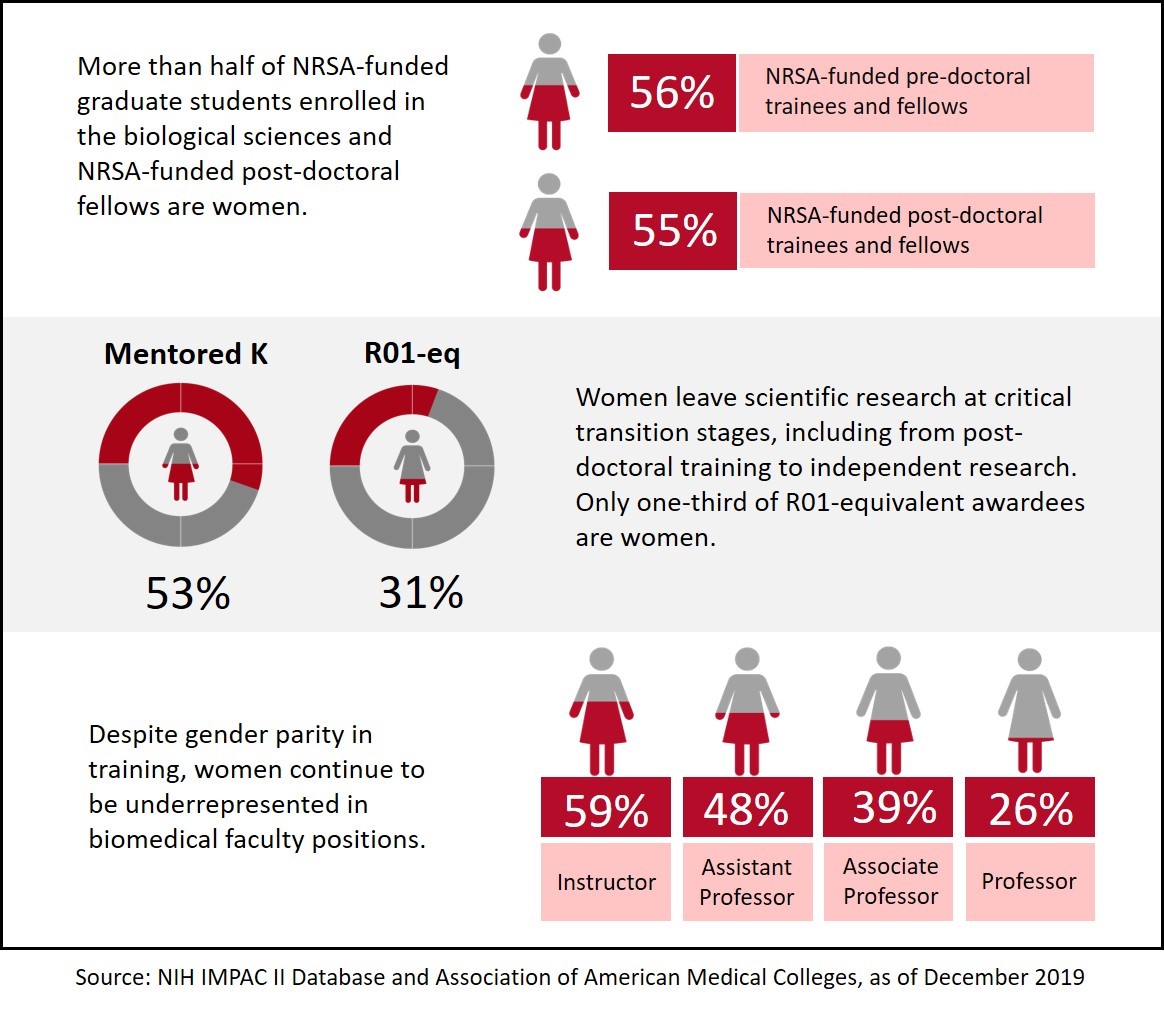6 Comments
Has your school made an important contribution to helping women become leaders in their field? Maybe your department made noticeable strides recently in diversifying the gender and race or ethnicity of its workforce? What about your institution’s response to reversing the “backward slide” experienced by women in biomedicine because of COVID-19?
Well, tell us about it! Your institution could improve leadership prospects for women in science—and win a prize.
On behalf of the NIH Working Group on Women in Biomedical Careers, the NIH Office of Research on Women’s Health has launched a new challenge competition to promote the advancement of women in leadership roles in academia. It is called the NIH Prize for Enhancing Faculty Gender Diversity in Biomedical and Behavioral Science. Dr. Janine Clayton, Director of the Office of Research on Women’s Health, described the competition as one that will recognize institutions that have successfully and systemically addressed gender diversity and equity issues among faculty members in biomedical and behavioral sciences (see her full post here.)
NIH has a long-standing commitment to supporting a diverse biomedical workforce (see our latest statement at NOT-OD-20-031.) As part of this commitment, we encourage institutions to consider women for faculty-level, diversity-targeted programs to address faculty recruitment, appointment, retention or advancement. Modest improvements have been seen in the representation of women in the biomedical research pipeline, but underrepresentation of women at advanced and senior faculty career levels remains a persistent issue. More details can be found in this NIH analysis and in these data from the National Science Foundation (see Table 9-23).
Let’s take a look further. My colleagues within the OER’s Division of Biomedical Research Workforce recently examined gender differences across the NIH-supported biomedical research pipeline (Figure 1). Using data from the NIH Data Book report #170, we see that more than half of pre- and post-doctoral trainees supported on National Research Service Awards (NRSAs) were women in fiscal year 2019 (top panel). This proportion also holds steady for mentored career development (K) awards, as seen in the middle panel. The gender gap is increased at the point of transition from K award to R01-equivalent grants. Only a third of R01-equivalent grants have women serving as principal investigators (See NIH Data Book report #172.)
Figure 1: Percentage of women at points along the biomedical research career path

Reviewing public data analyzed by the Association of Medical Colleges, women are underrepresented at the level of assistant professor (47 percent), associate professor (39 percent), and full professor (26 percent) (Figure 1, bottom). Among full-time women faculty, the proportion of women from an underrepresented in medicine race or ethnicity group was 12% in 2009 and 13% in 2018 (see this data report). To some extent, the lack of women in senior-level positions could be attributed to the “leaky pipeline” and other factors, such as women constituting a smaller percentage of the biomedical research trainee pool for years. However, the underrepresentation of women in senior-level faculty positions is not simply due to a pipeline problem.
The National Academies has recommended institutions who are working towards improving gender equity be recognized and celebrated as those promoting culture change. The Advisory Committee to the NIH Director echoed this sentiment, suggesting NIH award recognition for those who excel in this area.
This challenge competition will help recognize efforts across academia to directly address the underrepresentation of women in biomedical careers. We want to see your novel and effective practices that create more supportive, inclusive, and equitable environments. The strategies will inform the development of a larger toolkit of replicable, evidence-based best practices, lessons learned, and strategies that research institutions may consider to make their workplaces more equitable.
No one-size-fits-all approach exists. Thus, we encourage submissions from academic institutions of all sizes and types. This means departments and schools focused on basic, behavioral, or clinical science, Historically Black Colleges and Universities, minority-serving institutions, teaching schools, and research-intensive organizations are all welcome to apply.
Each submission will be judged on five criteria. The bulk of the score will be on the approach’s impact (magnitude and extent) on increasing gender diversity within the organization. Then there are the metrics enumerating the gender makeup before and after the approach. The final criteria include how sustainable the approach is, its ability to be scaled up and adapted, and how well an institution showcases lessons learned and roadblocks overcome.
Think the transformative efforts at your institution meet the mark? You can submit your approaches here until April 16, 2021. Ten winners from U.S.-based institutions will be selected, each receiving a prize of up to $50,000. Winning institutions and honorable mentions will also be invited to share their approaches at an NIH Office of Research on Women’s Health–hosted national scientific symposium. Be part of the solution and help us to recognize and celebrate your institution’s achievements in improving gender diversity and equity.



What about Individuals from Disadvantaged Backgrounds? NIH OD-20-031 has made the criteria for this group much clearer, but it is unclear if these individuals’ representation is being counted or fostered in any meaningful way.
Absolutely!!!!!
Why do we need this?
I work in a school where >75% of the academic admin and faculty are women. In fact more qualified men have been passed over just to hire women. This is not right but no one wants to discuss!
The most qualified get the positions!
interesting! Congratulations!!!!
May I ask the roles of these individuals (i.e how many women are in power?). And your racial-ethnic composition?
I’m so glad that this is being addressed. It is extremely easy to be a female junior faculty member in a trainee role. When it comes time to assume greater leadership roles, however, the bullying and subversion are intense. Female faculty=junior faculty.
The 50K award is not attractive enough to any institution to be interested in investing in such initiatives and even less in implementing it.